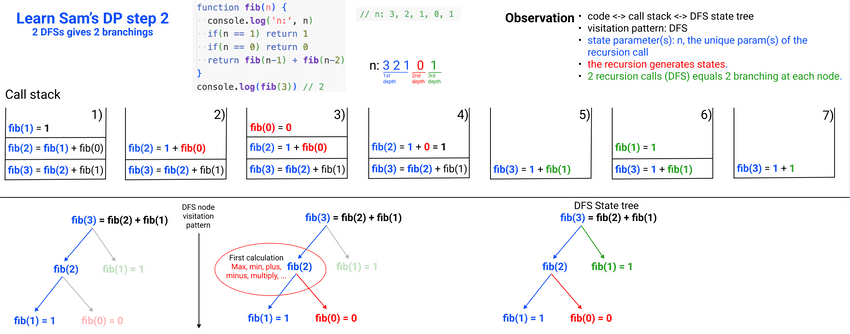This tutorial is a part of the Data Structures and Algorithms class:
- Outcomes after this Dynamic Programming (DP) series
- Prerequisites
- Introducing The Modern Law of Dynamic Programming (Sam's DP)
- Learn Sam's DP step 1: 1 Depth First Search gives 1 branching
- Learn Sam's DP step 2: 2 Depth First Searches give 2 branchings
- Learn Sam's DP step 3: 3 Depth First Searches give 3 branchings
- Learn Sam's DP step 4: generalize DFS branching & cutting
- Depth First Search branching & cutting summary
Outcomes after this Dynamic Programming (DP) series
- ✅ Understand what types of problem can be solved with DP
- ✅ Can actually apply modern DP to solve problems with 3 simple steps
- ✅ Can calculate the exact Time & Space complexity of a DP algorithm
- ✅ Clear your mind off the myths about DP related terms on the internet:
principle of optimality,find subproblem,optimal substructure,bottom up,top down,tabular approach,memoization approach -
✅ Use DP to solve these applications: 1. Min, 2. Max, 4. Find most optimal solution:
- Max profit/min cost/optimal choices
- Optimal sequence of actions to achieve best outcome
- Simulation: simulate different scenarios of something in life and choose the best scenario.
Prerequisites
- If you knew something about DP: temporarily forget everything you've heard about DP.
-
DP requires a lot of previous knowledge. ONLY proceed after learning these:
Introducing The Modern Law of Dynamic Programming (Sam's DP)
Paper: The Modern Law of Dynamic Programming by Sam Tran 2023
Paper: The Theory of Dynamic Programming - Bellman 1954 - original paper
What you're going to learn is very different. It's still Dynamic Programming. But it's very different from the original DP from the original author - Richard Bellman. And it's definitely very different from anything you can find on the internet (up to the time of making of this video). But to be clear, it's a continuation of understanding and applying DP. It doesn't mean to replace anything, rather, it's a supplement for you to better understand and apply DP. It'll be clearer with the comparison table later.
The purpose stays the same: Sam's DP purpose is to helps you to pass difficult coding interviews, understand and apply DP in your daily work, life.
Summary of The Modern Law of Dynamic Programming (Sam's DP):
- Sam's DP is a law, it can be proven. As opposed to Bellman's original DP, it was initially called a theory. Theory does not require proof.
- The difference: law is meant to be always true (with proof). Theory can be true or false (so no proof required). That means a
lawguarantees a result. Atheorycan/can't give a result. - Mainly designed for solving coding interview purposes.
- Secondly, to clear the myths about Dynamic Programming.
- Thirdly, to introduce the importance of computer simulation in human's life (now and far future).
The Modern Law of Dynamic Programming (Sam's DP)
If you can describe your system as follow:
- A system state: is comprised of a limited number of parameters.
- Choices to change state: is a limited, known number of choices to change the system state. You have the same choices at any state.
- Final states: are the states that achieve your desired information, or the states where you can't choose any choices to change system state.
- Can reach final states: after a finite number of choices to change state, you can reach your final state(s).
- Your system can fit in a computer in terms of RAM and CPU.
Then with Sam's DP:
- You are guaranteed to have a systematic procedure to design and code your solution.
- You are guaranteed to have the best answer based on your requirements (min, max, best course of actions, ...)
- The Time and Space Complexity of your solution are always equal.
- The Time and Space Complexity will be in polynomials (One of
O(n),O(n^2), ...).- The Space Complexity equals to the number of distinct states created.
Examples:
- You are the president of a nation. Your nation has money and choices to spend it. What activity do you choose to spend to make the most impact?
- You are a skilled worker, working 8h/day, 9-5. There are tasks associated with time frames and reward money. Which series of tasks should you choose to maximize earning within your work schedule?
Learn Sam's DP step 1: 1 Depth First Search gives 1 branching
First we'll learn about the importance of Depth First Search in DP: it helps to generate states with predefined choices. Focus on relating the code to the call stack to the DFS state tree.
// Learn Sam's DP step 1: 1 Depth First Search gives 1 branching
function factorial(n) {
console.log('n:', n)
if(n == 1) return 1
return n * factorial(n-1)
}
// n: 3, 2, 1, f(3) = 3*2*1 = 6
console.log(factorial(3)) // 6$ node factorial.js
n: 3
n: 2
n: 1
6Learn Sam's DP step 2: 2 Depth First Searches give 2 branchings
// Learn Sam's DP step 2: 2 Depth First Searches give 2 branchings
function fib(n) {
console.log('n:', n)
if(n == 1) return 1
if(n == 0) return 0
return fib(n-1) + fib(n-2)
}
console.log(fib(3)) // 2
// n: 3, 2, 1, 0, 1$ node fibonacci.js
n: 3
n: 2
n: 1
n: 0
n: 1
2Learn Sam's DP step 3: 3 Depth First Searches give 3 branchings
// Learn Sam's DP step 3: 3 Depth First Searches give 3 branchings
function tri(n) {
console.log('n:', n)
if(n == 2) return 1
if(n == 1) return 1
if(n == 0) return 0
return tri(n-1) + tri(n-2) + tri(n-3)
}
console.log(tri(5)) // 7
// n: 5 4 3 2 1 0 2 1 3 2 1 0 2$ node tribonacci.js
n: 5
n: 4
n: 3
n: 2
n: 1
n: 0
n: 2
n: 1
n: 3
n: 2
n: 1
n: 0
n: 2
7Learn Sam's DP step 4: generalize DFS branching & cutting
// Learn Sam's DP step 4: generalize DFS branching & cutting
function dfs(n) {
console.log('n:', n)
if(n == 2) return
if(n == 1) return
if(n == 0) return
isEven(n-1) && dfs(n-1)
isEven(n-2) && dfs(n-2)
isEven(n-3) && dfs(n-3)
}
console.log(dfs(5))
// n: 5 4 2 2
/**
* @param {*} num
* @returns true if number is even,
* return false otherwise
*/
function isEven(num) {
return num % 2 == 0
}
console.log(isEven(2)) // true$ node tribonacci-branch-cut.js
n: 5
n: 4
n: 2
n: 2
undefined
trueDepth First Search branching & cutting summary
- When seeing multiple recursive calls, you should no long be afraid. Instead you should comfortably draw state trees & understand code execution orders.
- When applying this DFS branching & cutting pattern, name your recursion function DFS to emphasize the important role of DFS.
- The DFS call generates states.
- Branching & cutting logic is independent with calculation.
- The number of DFS calls = the number of branches at each node.
-
There are 2 places to cut branching:
- return on top.
- true/false logic to run DFS calls within the body.
- Now you can use multiple DFS calls to create/cut whatever branching you want.
- Depth First Search is a subject we have learnt quite intensively. You can treat the DFS State Tree as a graph. And apply what you have learnt from with DFS to explore any kind of information you want: collecting nodes data in DFS pattern, calculate top-down or bottom-up, ...
Real life interview questions
- What is the importance of
DFStoDP? - Draw the mapping of a 2 choices, 3 choices call stack to
DFS state tree. - Draw call stack of Tribonacci and explain why the console outputs like so.
- Draw call stack of branch cut Tribonacci to check if the state print out is correct.
- Remove returned value(s) & remove calculation (
*,+) of factorial, fibonacci and observe if there are any changes on the state output in the console. Explain why/why not? - Use call stack to explain why
the first calculationof the functions (factorial, fibonacci, ...) always happens at thelast branching nodeon theleft most branch? - Draw
DFS state treeof quadonacci (4), code, print out states and draw call stack to check if yourDFS state treeis correct. - Apply different calculations: min, max, plus, multiply, minus, divide, see if the tree state output on the console is different. Why/why not?
- Choose a function with
DFSrecursive call(s) you were confused about before and apply this pattern to see if you can clearly understand what the function does now. Explain why yes/no?





